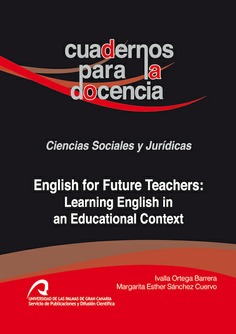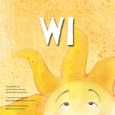
English for Future Teachers: Learning English in an Educational Context
Ivalla Ortega Barrera (Escritora) , Margarita Esther Sánchez Cuervo (Escritora)
English for Future Teachers: Learning English in an Educational Context es un cuaderno cuyo objetivo principal es el de familiarizar a los futuros docentes, tanto de Educación Infantil, como de Primaria y de Educación Social, con el inglés relacionado con su ámbito profesional. Para ello se proponen diversos textos y actividades orales y escritas relacionadas con la enseñanza y el aprendizaje, en las que predominan el vocabulario del área en cuestión y las expresiones más comunes de la especialidad.
- Escritora
- Ivalla Ortega Barrera
- Escritora
- Margarita Esther Sánchez Cuervo
- Colección
- CUADERNOS PARA LA DOCENCIA: CIENCIAS SOCIALES Y JURÍDICAS.
- Materia
- ELT: gramática, vocabulario y pronunciación, ELT: inglés para fines académicos
- Idioma
- English
- EAN
- 9788490422540
- ISBN
- 978-84-9042-254-0
- Depósito legal
- GC 446-2016
- Páginas
- 104
- Ancho
- 1,7 cm
- Alto
- 2,4 cm
- Edición
- 1
- Fecha publicación
- 19-07-2016
- Número en la colección
- 3
Contenidos
CONTENTS
PRESENTACIÓN CUADERNOS PARA LA DOCENCIA
INTRODUCCIÓN
TOPIC I: EDUCATION
1. Starting out!
2. Education
2.1. Understanding the text
2.1.1. Comparison
2.2. Words from the text
2.3. Finding out information
3. Revise your grammar. Relatives
3.1. Joining sentences
4. Useful grammar
5. Filling gaps
6. Words at work: Adjectives + prepositions
7. Types of state-funded schools in England
7.1. Understanding the text
7.1.1. True or false
7.1.2. Reading comprehension
7.2. Words from the text
7.3. Filling gaps
8. Language focus
8.1. Rephrasing
8.2. Making suggestions
8.3. Speaking out
9. Revise your grammar. The passive voice
9.1. Rewrite the following sentences
9.2. Write the active forms
TOPIC II: TEACHING AND LEARNING
1. Starting out!
2. Being a teacher
2.1. Understanding the text
2.2. Words from the text
2.3. Useful grammar
2.3.1. Give the references
3. Filling gaps
4. Revise your grammar. Reported speech (questions, orders, requests)
4.1. Choosing the correct answer
4.2. Rewrite the following sentences
5. Language focus
5.1. Rephrasing
5.2. Complete the crossword
5.3. Writing
6. Learning styles in the classroom
6.1. Understanding the text
6.1.1. Answering questions
6.1.2. True or false
6.2. Words from the text
7. Words at work
8. Filling gaps
9. Finding words
10. Writing. Paragraphs
10.1. Join sentences to write paragraphs
10.2. Writing your own paragraph on learning
TOPIC III: IN THE CLASSROOM
1. Starting out!
2. In the classroom
2.1. Understanding the text
2.2. Summary
2.3. Words from the text
3. Filling gaps
4. Language focus
4.1. Rephrasing
5. Words at work
6. Revise your grammar. Conditionals
6.1. Matching
6.2. Writing
7. Speaking out
8. Special Needs
8.1. Understanding the text
8.1.1. Reading comprehension
8.2. Words at work. Acronyms
8.2.1. Joining acronyms with their definitions
8.3. Selecting key words from the text related to the educational. field
8.4. Words from the text
9. Filling gaps
10. Speaking out. Taking decisions in class
TOPIC IV: LESSON PLAN
1. Starting out!
2. Lesson plan
2.1. Understanding the text
2.1.1. True or false
2.2. Words from the text
2.3. Definitions
3. Revise your grammar. Linking words
3.1. Connectors
3.2. Completing sentences
3.3. Phrasal verbs
4. Filling gaps
5. Finding out information
6. Words at work
7. Blooms taxonomy
7.1. Finding out information
7.2. Words from the text
7.3. Words at work
TOPIC V: CONTENT AND LANGUAGE INTEGRATED LEARNING (CLIL) & MULTIPLE INTELLIGENCES
1. Starting out!
2. Content and language integrated learning (CLIL)
2.1. Understanding the text
2.2. Finding out information
2.3. Word definition
3. Filling gaps
4. English teaching and learning
4.1. Acronyms
5. Multiple intelligences
5.1. Understanding the text
6. Educational technology
6.1. Translation
BIBLIOGRAPHY


